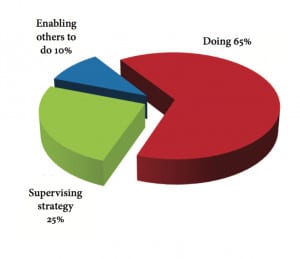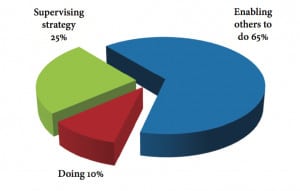We have a new name. We have been the Vancouver Volunteer Centre or Volunteer Vancouver for 66 years. Our new name is Vantage Point. You might ask, “Why the change?” The answer is: Because the world is changing. Fast. Really fast. Since the inception of our volunteer centre in 1943, Canadian society and volunteer engagement have undergone significant change—particularly with regard to technology, demographics, and the workplace. Our organization has changed to keep pace and stay relevant in the many communities we have grown to serve. In the past, Volunteer Vancouver focused primarily on volunteers, and our former name suggested that that was what we did. But in the past 66 years, as we have studied the voluntary sector, we have learned that for volunteers to be successful, we must focus on the organization, not the volunteer. We believe that our specific and unique vantage point is working with organizations to engage volunteers in order to help organizations achieve their missions and to ensure that our organization is successful in delivering its mission, which is to inspire and build leadership in the voluntary sector.
One of the first things we realized this decade—particularly since September 11—is that the supply and demand equation of volunteering is not what most people think. It is, in fact, exactly the opposite. Many assume there is a lack of volunteers. We believe something else: that there are many willing volunteers but very little demand for them in the ways in which they would like to be engaged. That is seldom recognized and certainly poorly understood by community organizations, which most often believe only in traditional roles for volunteers. We believe that if the demand from organizations was more in line with what today’s volunteer seeks in a volunteer role, the volunteering conversations going on in North America might be quite different. We discuss this idea further in our latest Vantage Point blog post at http://www.volunteervancouver.ca/node/137 .
How can we define this unbalanced equation more specifically? Well, try this:
1. Traditional volunteers come to work with their hearts and their hands. 2. What we call today’s “next” volunteers come to work with their hearts and their heads. We selected this term as there have been a limited number of volunteers fulfill these roles in the past, so it is not really a new volunteer. We believe it will become the primary role of the volunteers that emerge in this next decade: the next volunteers.
In our traditional model, there is typically a schedule and tasks for volunteers to do, e.g., visit people, act as receptionists, mail our newsletters, plant trees, fill boxes with food, take tickets, etc. This worked in the past when people had more rigid schedules and more linear lives. But we have found that when we work with the “next” volunteers, they want to be intimately engaged; they want to make a difference on their own terms. So part of what confounds us is that we cannot schedule them. They want flexibility. They also want to know that we have capitalized on their valuable time. We have to learn how to meet these expectations. It is a different method of working.
We must also think of volunteer engagement as a factor earlier in the planning cycle. In past times, our practice has been to plan a project and then have volunteers come in and execute part of it. What if we had volunteers brainstorm and create a project with us and then asked them to plan the project for us? Many volunteers have the talent to create programs and projects—because they have specific expertise in an area. Paid employees would then execute the program. This becomes a different model.
The practice of engaging volunteers’ hearts and heads can revolutionize an organization and the way it delivers service. Vantage Point created a book of stories, A People Lens (http://www.volunteervancouver.ca/content/people-lens) about this next kind of volunteer engagement. It contains examples of different, non-traditional ways to involve people as volunteers.To write the book, we “hired” a volunteer project manager and volunteer writers, graphic artists, photographers, and editors. In fact, the next generation of volunteers made this book happen from start to finish.
We discovered that we really can engage people with their hearts and heads, not only their hands, and that we can engage volunteer experts earlier in the cycle of any program or project. Our book tells stories about many different ways of involving people who are paid through motivation and involvement rather than money. That answer is the easier of two questions: “ What” can volunteers do for our organizations and our missions? But, harder to answer is “How” can we integrate volunteers into our organizations for the greatest possible positive impact? Vantage Point is a student of “how,” and once again the answer is not what most people think. It turns out “how” has to begin with “who.”
The essential first player is the executive director. For the executive director to engage volunteers effectively, she must first focus on the organization’s paid employees. Susan Ellis, in her book From the Top Down (http://www.energizeinc.com/store/1-102-P-1), writes of the importance to an effective volunteer program of total buy-in from the executive director. We go one step further to state (vehemently!) that executive directors must ensure intentional volunteer engagement in their organizations. They are in the best position to engage significant volunteer skills and large numbers of volunteers in the organization. In order to do this, the executive director must be a facilitative leader, and the leadership team in the organization must be comprised of leaders who understand that they cannot get all their work done most effectively by themselves but that they must be willing to engage—and be excited about engaging—other brilliant minds to move their missions forward.
How likely is this to happen?
Currently we observe many leaders who are doers and who cultivate other doers in the rising leadership of their organizations. These doers get all the work done themselves and leave little to no room for “next” volunteers who might like to engage their heads in the organization. Unfortunately, this traditional model of doers means that the organization and its leadership has no capacity to move to the new model that we need.
So how do we change? In what ways can we begin to create new organizations that actually engage the next volunteer, that is, those people who are in the community and happy to lend us their brains along with their hearts? Simply put, we believe that organizations must:
1. Be mission driven. There must be a culture of planning how to deliver your mission. When you begin to engage brilliant and creative people in your organization, you may fear that they will run away with your projects and you will have no say in what they
are doing. But this will happen only if you cannot tell everyone clearly where you are going and the big ideas (goals, directives, buckets) into which all programs and projects must fit.
2. Have an effective board. The question isn’t whether you have a working board or a policy board or any of those old definitions. It is whether you have a board that understands that its role as a board is governing, not doing. We have found the work done at BoardSource in Governance as Leadership (http://www.boardsource.org/Bookstore. asp?Item=161) illustrates the type of board involvement that will work. 3. Focus on strong people practices for paid employees. We have had the good fortune to work closely with the HR Council (http://hrcouncil.ca) for the past several years. They have uncovered clear evidence that there has been an amazing dearth of good people practices (often, in fact, of any people practices) in not-for-profit organizations (see http://hrcouncil.ca/trends-issues/trends-issues.cfm). Their research prompted our educational opportunities for executive directors and the other leaders who look after the people in their organizations. Only an organization that has a focus on people can begin to engage the next volunteer. 4. Ensure that the executive director and leadership team spend most of their time on planning and enabling and very little on doing. Anecdotally, we find that most senior leaders in not-for-profit organizations spend their time in this way:
In order to begin to engage the next volunteer—and employees—we believe that leaders must be spending their time this way:
5. Understand and practice intentional workforce planning. This means that executive directors should present a people resources plan to the board annually in the same way that they present a financial resources plan. It also means we must change how we plan for the future. We have traditionally said, “We have this much money, so we can get
this much done.” In a new model, we must examine what we want to achieve to deliver our mission and then determine what skill sets this will take and which roles should or could be performed by paid and unpaid (i.e., volunteer) personnel. Then, for those people who are paid, we can examine salaries, benefits, and costs of development, and insert that amount in our financial plan.
6. Embrace volunteer accountability. Paid-employee accountability is a given. The paid people in the organization must truly examine the ways they can involve volunteers and also create the parameters in which they will work. Organizations must throw out traditional thinking about volunteers that has us all operating as if volunteers can do only “hands” tasks, do not have to (or really can’t) accomplish anything, don’t have to be on time, can’t be fired, because they’re volunteers, etc. We recognize that we have done ourselves a large disservice by allowing Joe and Josephine Public to assume being a volunteer equates to not being accountable. It is important that we are deliberate in understanding that we must work with volunteers as not-paid-with-money-and-paid—in-other-ways employees. We will not give them a cheque every month—and we will provide them with some form of payment. Most often that will be a feeling of making a difference or learning something new. This prompts another question: How often do we actually ask volunteers what they would like to achieve by volunteering with us?
Does your organization focus on people first? How do you demonstrate that? Are your people practices current and continuously evolving? Or do you really believe sustainability is only about the money?
We work from a vantage point that sustainability is about people first. That is very different from operating with a focus first on financial resources—the way organizations have operated from the time the sector began to professionalize. Sustainability is also about understanding that people are the competitive advantage of the not-for-profit sector. We have the ability to engage people to whom we don’t have to pay a salary—people who have amazing talents they will contribute to our organization because they are passionate about our cause. We may have to pay more money to the paid employees in order to attain the skills we require from them. This will take considerable education. Vantage Point is up for that educational role. We are happy to carry that torch and begin to work to provide opportunities for others to think in new and different ways about how we will divide the work and to ensure we are enabling others to do the work, rather than doing it all ourselves. That is our Vantage Point.
Colleen Kelly & Virginia Brown, Vantage Point
Colleen Kelly is Executive Director, Vantage Point, formerly Volunteer Vancouver, Vancouver, B.C. Since 1999 she has lead a team of 10 employees and approximately 200 volunteers who deliver nine programs including GoVolunteer.ca, a full program of workshops on organizational development, Board Development training, Executive Director Institutes, Board Chair Academies & Leadership Learning Circles. She works with many talented people to develop resources, tools, and programs to offer to other organizations to assist them in a focus on engaging people’s talents to further their organizational missions. Email: ckelly@thevantagepoint.ca
Virginia Brown was a Program Director at Vantage Point and works as an expert on organizational development and community engagement in delivering mission. Her background includes a focus on marketing and fundraising in both the corporate and not-for-profit sectors. She has a Master’s Degree in Business Administration from the Crummer Graduate School of Business in Florida. Email: virginia.warren.brown@gmail. com; http://www.linkedin. com/in/virginiawarrenbrown.



